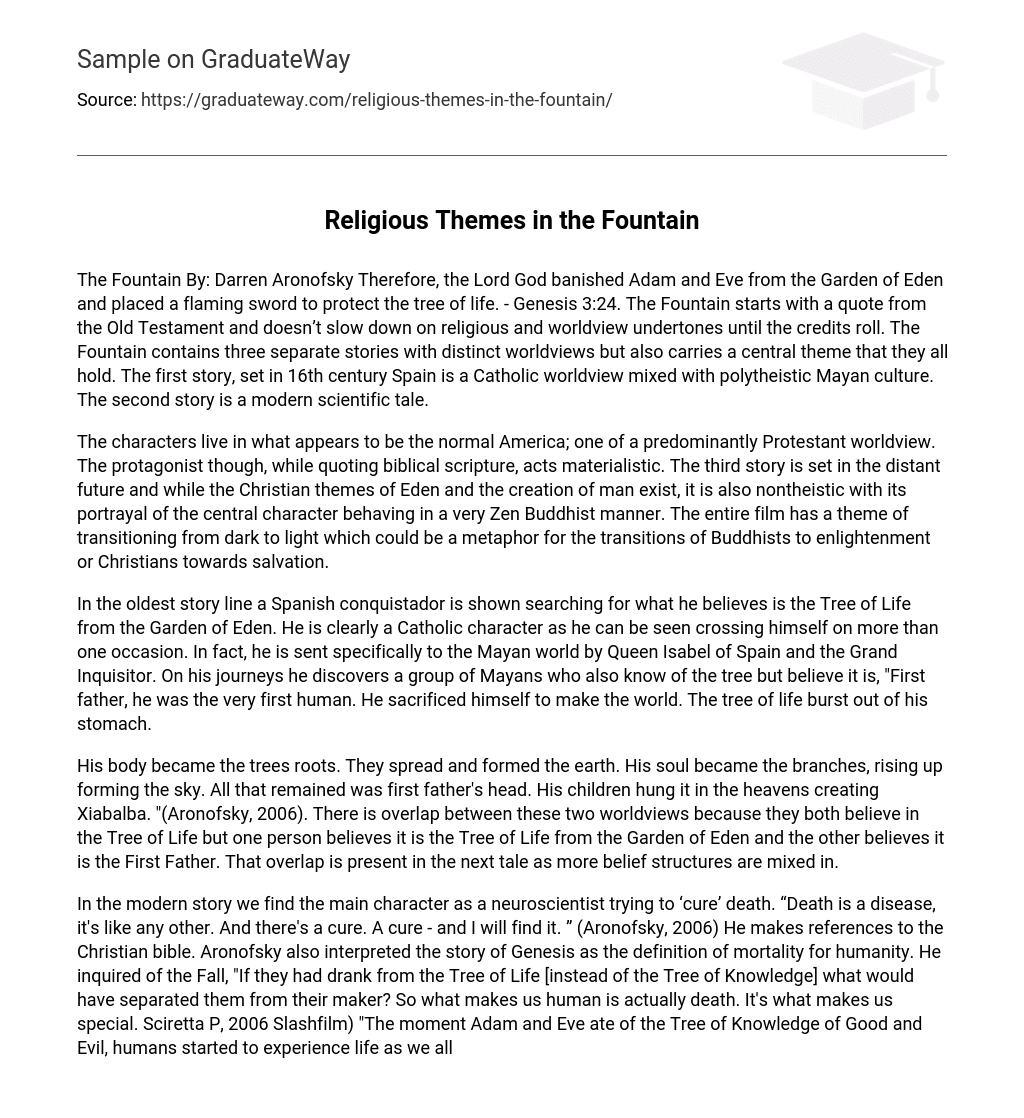The Fountain By: Darren Aronofsky Therefore, the Lord God banished Adam and Eve from the Garden of Eden and placed a flaming sword to protect the tree of life. – Genesis 3:24. The Fountain starts with a quote from the Old Testament and doesn’t slow down on religious and worldview undertones until the credits roll. The Fountain contains three separate stories with distinct worldviews but also carries a central theme that they all hold. The first story, set in 16th century Spain is a Catholic worldview mixed with polytheistic Mayan culture. The second story is a modern scientific tale.
The characters live in what appears to be the normal America; one of a predominantly Protestant worldview. The protagonist though, while quoting biblical scripture, acts materialistic. The third story is set in the distant future and while the Christian themes of Eden and the creation of man exist, it is also nontheistic with its portrayal of the central character behaving in a very Zen Buddhist manner. The entire film has a theme of transitioning from dark to light which could be a metaphor for the transitions of Buddhists to enlightenment or Christians towards salvation.
In the oldest story line a Spanish conquistador is shown searching for what he believes is the Tree of Life from the Garden of Eden. He is clearly a Catholic character as he can be seen crossing himself on more than one occasion. In fact, he is sent specifically to the Mayan world by Queen Isabel of Spain and the Grand Inquisitor. On his journeys he discovers a group of Mayans who also know of the tree but believe it is, “First father, he was the very first human. He sacrificed himself to make the world. The tree of life burst out of his stomach.
His body became the trees roots. They spread and formed the earth. His soul became the branches, rising up forming the sky. All that remained was first father’s head. His children hung it in the heavens creating Xiabalba. “(Aronofsky, 2006). There is overlap between these two worldviews because they both believe in the Tree of Life but one person believes it is the Tree of Life from the Garden of Eden and the other believes it is the First Father. That overlap is present in the next tale as more belief structures are mixed in.
In the modern story we find the main character as a neuroscientist trying to ‘cure’ death. “Death is a disease, it’s like any other. And there’s a cure. A cure – and I will find it. ” (Aronofsky, 2006) He makes references to the Christian bible. Aronofsky also interpreted the story of Genesis as the definition of mortality for humanity. He inquired of the Fall, “If they had drank from the Tree of Life [instead of the Tree of Knowledge] what would have separated them from their maker? So what makes us human is actually death. It’s what makes us special. Sciretta P, 2006 Slashfilm) “The moment Adam and Eve ate of the Tree of Knowledge of Good and Evil, humans started to experience life as we all experience it now. ” (Aronofsky, 2006) The references to Adam and Eve show that this is a Christian worldview, though no specifics as to which type. The idea though that death can be cured means that the main character feels that death is material. There is a scene set in modern times when the protagonist’s wife is describing the Mayan underworld Xiabalba and then later shows her husband a place in the stars that she believes could be Xiabalba.
Given that the story takes place in what is likely the modern United States, her belief in the Mayan underworld is most likely bred from a New Age mentality. The New Age combination of different practices is also clearly present in the third story. In the futuristic story we can see the Zen Buddhist form of the main character. Our protagonist has found the Tree of Life. He sits next to what is arguably a deeply Judeo-Christian image but his lotus position, rhythmic chanting, and his belief that he can sustain himself solely on small pieces of bark and the energy of the universe are heavily Zen Buddhist.
His whole persona is one that invokes the image of seeking enlightenment, though we know because of who he is that he did not start as a Buddhist and this is worldview is less of a distinct Judeo-Christian or Buddhist image and more of a New Age blending. Just as the different worldviews were present throughout the film so too was a common thread. The central theme throughout the movie is one the director says is, “a movement from darkness into light, from black to white” (Murray R, 2006, About). The movie fades in from black and the fades out in white.
The entire shade of the movie moves from dark to light as the film progresses. Buddhists believe that through meditation and practice they can find their way through the darkness of this world and into the light of nirvana. The Christians too believe that God is light and separation from God is separation from light. The only way to regain the light is to transition from darkness to the light through salvation. This movie leans heavily on several worldviews and as such doesn’t have one specific worldview at all but several.
It is up to the viewer to interpret what he or she sees and find the message. References: Aronofsky, D. (Director). (2006). The Fountain [DVD]. United States: Warner Bros. Murray, R (2006). Darren Aronofsky talks about The Fountain About. com. Retrieved from http://movies. about. com/od/thefountain/a/fountain101906_4. htm Sciretta, P (November 21, 2006). Interview: Darren Aronofsky, director of The Fountain /FILM. Retrieved from http://www. slashfilm. com/article. php/20061121aronofskyinterview2.





